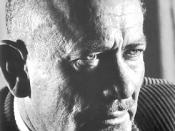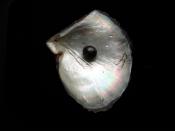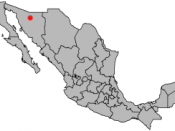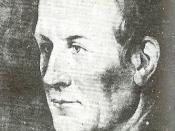The Pearl, by John Steinbeck, is the fateful tale of greed and it?s consequences. When the news of Kino?s great pearl spreads through La Paz, no one can imagine the power it will give to the young man. A power that may destroy his life, love, and family.
It was early morning when Kino opened his eyes and looked around the shabby hut. The young man glanced at Juana, who was wide-awake, as usual. She got up, off of her mat and began to make breakfast. Kino?s wife placed Coyotito, their son, in his hanging box right after she cleaned and fed him.
A littler while later, when the waking sun shone on the baby, Kino and Juana saw a terrible sight. There was a scorpion climbing down the rope of the hanging box that the baby was in. Coyotito reached out for the deadly insect as his father tried to come closer in order to kill it.
Unfortunately the little boy shook the rope by moving and the scorpion came tumbling down, stinging Coyotito. The baby cried out in pain, as Kino began crushing the enemy.
Upon hearing the little boy?s shriek, all the villagers rushed to the little cottage, full of wonder and horror. Everyone followed the young man to the doctor?s grand house. This greedy man would not allow Kino in with the baby because they were poor natives who did not have enough money to pay for the treatment.
Later that morning, Juana, with Coyotito, and Kino set out in their canoe to go pearl diving. The young woman prayed that a great pearl would be found, large enough to pay for the doctor?s help in taking care of the scorpion bite. Meanwhile, while Kino was diving for pearls. He saw one oyster open it?s shell and a bright light flowed out of it. He grasped the oyster and swam back to his canoe. Kino gently opened the shell and rolled the most beautiful pearl he had ever seen. It was as large as a seagull?s egg, perfect as the moon.
In the afternoon, when all his neighbors were viewing the magnificent pearl, Kino began reciting his family?s future. He and Juana would have a marriage ceremony and celebration. Coyotito would be baptized and go to school. Kino went on to say that he would have a rifle, a harpoon, and new clothes. Everybody was amazed at his words and did not know whether to say that he was wise or foolish to say such things.
Later that day, Kino buried his prize pearl, knowing that people would do anything to own the pearl. Right after he finished hiding it, the doctor came to the door. He said that he was terribly ?sorry? that he could not help the baby sooner. The greedy man said that he had been away from the house and was treating another person. Coyotito was given a tonic and the doctor said that he would return in one hour. As the minutes passed, the child began to look ill. He now had a fever.
When the hour was over, the doctor returned. This time he said the poison was working and gave the baby more medicine. The doctor said that Coyotito would recover. He then asked when Kino would be able to pay the medical fee. Kino said that he would pay as soon as he sold the pearl. The doctor asked if he could put the treasure in his safe, where nothing would happen to it. Of course the young man disagreed, but he looked at the spot where it lay, buried.
That night, Kino heard an intruder digging where the pearl lay. He took his knife, and like a cat, pounced on the intruder, who scampered away into the night. Juana found that Kino?s head was bruised and washed it. Kino then reburied the pearl under his mat.
The next day, Kino and Juana went to a pearl dealer?s shop in town. He asked the dealer how much it was worth. Rolling it between forefinger and thumb, the man examined the pearl. He said it was worth 1,000pesos. Kino had the other pearl dealers come to the shop, not believing the value. The other three men said the same price as the first one, even though they knew it was worth much, much, more. They would say that the pearl would loose its color in a few weeks or that it was too large for market. Angrily, Kino stormed out of their office and headed towards his home. He said that he had been cheated and probably had been cheated on the price of his pearls many more times in the past. Kino then decided to take his treasure to the capital.
Suddenly, the young man heard a noise outside the hut. Juana took a stone from the fireplace and rushed out to see what was happening, but it was all over. There was a bloody gash on Kino?s head and he was half conscious. The woman said that the pearl was full of evil. ? Let us destroy it before it destroys us. Let us crush it between two stones. Let us- Let us throw it back into the sea where it belongs. Kino, it is evil, it is evil!? He refused to destroy the pearl, for it was their only chance to gain money and a good life. The couple then went to sleep, promising each other to fight against the evil of the pearl.
Kino awoke from a slight movement. In the moonlight, he saw his beloved wife unearth the Pearl of Evil and race out of the door. He quietly followed her, rage swelling inside him, and then he attacked her, just as she was about to throw the pearl into the water. Juana lay there, not frightened by Kino. He took the pearl from her and walked away.
Suddenly, Kino was taken by greedy hands and searched. He took his knife and pierced the man?s neck. Juana rushed over to him to see what was going on. Full of worry and concern for their lives, she helped hide the corpse in the brush. Kino and Juana would have to flee from La Paz. The young woman rushed to the hut to fetch Coyotito, and Kino went to get the canoe. To his surprise, he found that someone or something had destroyed the canoe. As Kino began to walk home, he saw flames covering his hut and Juana running towards him with the baby. They explained to each other what each had found and decided to hide with Kino?s brother and sister. Juan Tomas supplied them with food, water, and tools for their journey to the capital. The next night, they set off on their excursioin.
Luckily there was a strong wind that erased their tracks and allowed them to travel without concern. During the day, Kino, Juana, and Coyotito laid in a small clearing that as hidden from the road. In the afternoon, danger arrived. Kino saw three people searching for him, trackers. When they left, he and Juana fled to the mountains and hid in a few little caves. At dusk, the trackers camped, not too far away from their hideout. The young man noticed that one tracker held a rifle. If he could get that rifle away and kill that man, everything would be fine again. He began to prepare for the attack.
Sometime before the moon rose, Kino crept down, behind a rock, watching the tracker with the rifle. Suddenly Coyotito cried out and Kino, with his knife, leapt onto the tracker. In the struggle of life and death, bullets flew everywhere, until the trackers were all lying down, never to see daylight again. Amidst the sounds of bullets that were raging in Kino?s ears, was a cry. The cry of death.
The next day Kino and Juana returned to La Paz. The woman held a limp heavy bundle. It was the baby; he had accidentally been shot and was gone forever. The couple walked to the Gulf, weary and tired. Kino held up the pearl. All of the evil it brought flashed through his mind. With all of his strength, he threw the pearl into the ocean. The pearl sank to the ocean floor and faded from sight.
The Pearl, by John Steinbeck, was very similar to Scott O?Dell?s, The Black Pearl. Both of the authors set their stories in La Paz, Mexico and the main character in each portrays a poor native who wishes for a better life. The pearl for all that it is worth, is thought to bring new opportunities and hope in both books, but in reality only brings with it destruction.
After reading The Pearl, I believe that Scott O?Dell used the theme of this book and wrote a children?s book, with a gentler, less violent account of the tale.
What I find similar to many people today in relation to this book is that they strive and wish for a different life than they have. Some want jobs with more money; some simply want to further their education for better paying jobs, and some just wish they could win at Lotto. When Kino found the pearl, which was worth a fortune, his Lotto, he did not create a better life for himself or his family. Instead he destroyed them and their love. He did not see what he had; he was blinded by money and what he thought he wanted. By this, I see that first you must be happy and content with what you have and know that the love of family has a greater value than any material possessions a person may feel that they must have or need, or the job you have or how much money you have.
In our lives, having the privilege to go to school, studying what interests us, and working at a job that you enjoy and support your life with, is more of an accomplishment than having a job that you dislike, but are making millions of dollars doing. It seems similar to the pearl and the fate, which it brought to Kino. Many people who have too much money are unhappy and find themselves turning desperately around and around to find happiness and love, things that are lost from them forever.
The pearl not only changes Kino from a happy, content father simply wishing for an education for his son, to a man on a path of greed, destruction, violence and eventually becoming an outcast among his people. From this, we must learn to use our good fortune wisely. I am sure that if I were to win the lotto, I would keep enough money to go to school and buy a house, but then I would use a good portion to help others in the world who do not have clothes or food?. Something Kino did not think about.
This book teaches a very important lesson about what people think is valuable and what is important in life. Kino was blinded by the value of the pearl and lost sight of how rich his life was.
I hope that I will always remember this book and the value of the pearl.





